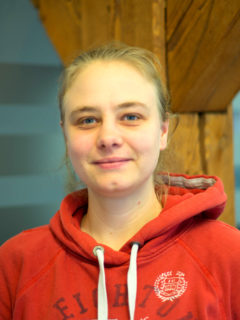Katharina Aholt
Katharina Aholt
Advisors
Arne Küderle (M.Sc.), Christine Martindale (M.Sc.), Prof. Dr. Jochen Klucken, Prof. Dr. Björn Eskofier
Duration
07/2018 – 01/2019
Abstract
Parkinson’s disease is a long-term degenerative disorder of the nervous system which mainly affects the motor system. Recent studies have shown that rhythmic auditory stimulation (RAS) improves gait performance in PD patients [1]; they achieve improved walking speeds, step lengths and step cadence [2, 3]. Home based solutions for monitoring the disease are being developed, as various cuing devices using smart phone based Apps for RAS [2, 4, 5, 6, 7] or using an RAS App as a solution when freezing of gait is detected [8].
Currently, none of these solutions provide real-time analysis of the RAS with respect to temporal gait parameters nor feedback about performance to the patient. This could be achieved by adding sensors to the App to allow monitoring of RAS and its effect and to give feedback on the quality and quantity of the exercises, with the additional benefit of being able to provide gait analysis.
This thesis aims to fill this gap by implementing standard gait analysis methods into an existing RAS App (HOOP) and proposing a robust algorithm for the assessment of the RAS with respect to gait. Furthermore, this algorithm will be used to allow the RAS to be adapted to the users’ speed or to enable a goal orientated RAS. This is the first step towards assessing the clinical relevance of a home-based RAS system
References:
- Nombela, C., Hughes, L. E., Owen, A. M., & Grahn, J. A. (2013). Into the groove: Can rhythm influence Parkinson’s disease? Neuroscience & Biobehavioral Reviews, 37(10), 2564-2570.
- Nieuwboer, A., Kwakkel, G., Rochester, L., Jones, D., van Wegen, E., Willems, A. M., Chavret, F., Hetherington, V., Baker, K. and Lim, I. (2007). Cueing training in the home improves gait-related mobility in Parkinson’s disease: the RESCUE trial. Journal of Neurology, Neurosurgery, and Psychiatry, 78(2), 134-40.
- Lim, I., van Wegen, E., de Goede, C., Deutekom, M., Nieuwboer, A., Willems, A., Jones, D., Rochester, L., Kwakkel, G. (2005). Effects of external rhythmical cueing on gait in patients with Parkinson’s disease: a systematic review. In: Clinical Rehabilitation, 19, 695-713.
- (2018). Parkinson’s on the Move Terms & Conditions of Use Agreement. https://pdonthemove.com/
- Goericke, S. (2012). Deutsche Parkinson Hilfe e. V. https://www.deutsche-parkinson-hilfe.de/förderprojekte/moveapp/
- 9zest, https://9zest.com/
- Hausdorff, J. M., Lowenthal, J., Herman, T., Gruendlinger, L., Peretz, C., & Giladi, N. (2007). Rhythmic auditory stimulation modulates gait variability in Parkinson’s disease. European Journal of Neuroscience, 26(8), 2369-2375.
- Mazilu, S., Blanke, U., Hardegger, M., Tr, G., Gazit, E., Dorfman, M., & Hausdorff, J. M. (2014). GaitAssist: A wearable assistant for gait training and rehabilitation in Parkinson’s disease. PerCom Workshops, Budapest

